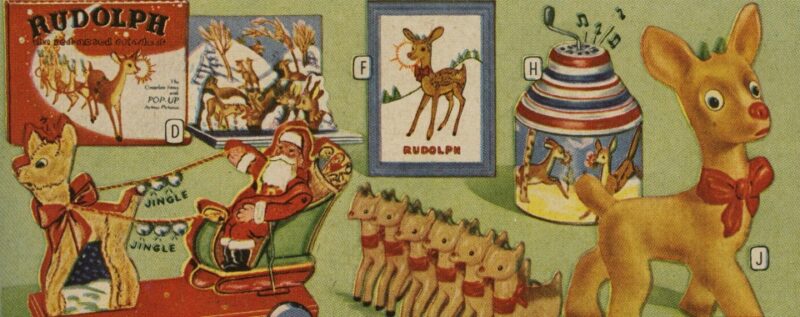Rudolph the Red-Nosed Reindeer is a beloved figure in Christmas lore, known for his glowing red nose and the pivotal role he played in saving Christmas for Santa Claus. But Where Did Rudolph the Red Nosed Reindeer Come From? How did Rudolph’s story become such an integral part of holiday traditions? And if you’re a fan of this festive character, be sure to check out the Rudolph the Red-Nosed Reindeer T-shirts available at Alibaytoon Store to celebrate the holiday season in style.

Where Did Rudolph the Red Nosed Reindeer Come From?
Rudolph the Red-Nosed Reindeer was not originally conceived as part of traditional Christmas folklore like Santa Claus or his other reindeer. Instead, Rudolph was born out of a marketing strategy by a department store. The story began in 1939, when the American department store Montgomery Ward tasked one of its copywriters, Robert L. May, with creating a Christmas-themed booklet to give away to children during the holiday shopping season.

Montgomery Ward had traditionally purchased coloring books to hand out to customers during Christmas, but to save money, they decided to create their own original story. Robert L. May, a staff copywriter and aspiring author, was given the assignment to create this new holiday character. Little did he know that his creation would go on to become one of the most beloved Christmas icons.
May was inspired by the classic “ugly duckling” story, which follows an outcast who ultimately triumphs despite being different from everyone else. Rudolph’s red nose became the defining trait that set him apart, and just like the ugly duckling, he would find his place by turning his perceived weakness into a strength.
The Original Story of Rudolph
The original story of Rudolph the Red-Nosed Reindeer was published as a 32-page illustrated booklet and was an instant hit. May’s tale followed Rudolph, a reindeer who was teased and ostracized by his peers because of his glowing red nose. However, on a foggy Christmas Eve, Santa realizes that Rudolph’s nose can light the way through the fog, and he asks the young reindeer to guide his sleigh. Rudolph accepts the task, and by the end of the night, he becomes a hero, respected and admired by all.

May’s creation resonated with the public, and the department store distributed 2.4 million copies of the booklet in its first year. Due to its popularity, Montgomery Ward continued to give away Rudolph the Red-Nosed Reindeer booklets for several years, and by 1946, the store had handed out more than 6 million copies. The story’s themes of acceptance, perseverance, and the triumph of the underdog made it a Christmas favorite.
How Rudolph Became a Christmas Icon
While the original booklet was a success, it wasn’t until the 1940s that Rudolph truly cemented his place in Christmas lore. In 1947, Robert May’s brother-in-law, Johnny Marks, wrote a song based on the story. Marks was a talented songwriter and saw the potential in turning Rudolph’s story into a Christmas song. His composition, Rudolph the Red-Nosed Reindeer, was first recorded by country singer Gene Autry in 1949.

Gene Autry’s rendition of the song became a massive hit, selling more than 2 million copies in its first year alone. It reached number one on the U.S. charts and became one of the best-selling Christmas songs of all time. The song’s success spread Rudolph’s fame far beyond the original booklet, and he quickly became a cultural phenomenon.
The catchy melody and heartwarming lyrics of the song helped make Rudolph a household name. The song’s popularity was further bolstered by its frequent radio play, and by the 1950s, Rudolph had firmly taken his place alongside other Christmas icons like Santa Claus and Frosty the Snowman.
The 1964 TV Special: A Christmas Classic
One of the most significant moments in Rudolph’s rise to holiday stardom came in 1964, with the release of the stop-motion animated TV special Rudolph the Red-Nosed Reindeer. Produced by Rankin/Bass Productions, the special brought Rudolph’s story to life in a new way and introduced a number of beloved characters, including Hermey the Elf, Yukon Cornelius, and the Island of Misfit Toys.
The Rudolph the Red-Nosed Reindeer TV special premiered on NBC on December 6, 1964, and was an immediate hit with audiences. The stop-motion animation, known as “Animagic,” was a unique and groundbreaking style at the time, and it added to the special’s charm and appeal. The special became an instant Christmas classic, and it has aired annually ever since, making it one of the longest-running holiday specials in television history.
The TV special expanded on May’s original story by adding new characters and subplots, such as Rudolph’s journey to the Island of Misfit Toys and his friendship with Hermey, an elf who dreams of becoming a dentist. These additions further enriched the story and helped endear Rudolph to new generations of viewers.
The Enduring Popularity of Rudolph
More than 80 years after his creation, Rudolph the Red-Nosed Reindeer continues to be one of the most recognizable and beloved Christmas characters. The reasons for Rudolph’s enduring popularity are numerous, but at the core of his appeal is the timeless message of the story.
Rudolph’s tale speaks to anyone who has ever felt different or excluded, and it offers hope that those differences can become strengths. His journey from outcast to hero is one that resonates with audiences of all ages, making his story both relatable and inspiring.
In addition to the annual TV broadcasts of the 1964 special, Rudolph’s story has been adapted into numerous formats, including books, stage productions, and animated films. The character has also been featured in a wide range of merchandise, from toys and clothing to holiday decorations and collectibles.
Rudolph’s Place in Modern Pop Culture
Rudolph’s impact on Christmas culture is undeniable, and his story has transcended its original marketing roots to become a cherished part of holiday traditions. He is now a symbol of Christmas itself, appearing in holiday parades, decorations, and advertisements worldwide.
The song Rudolph the Red-Nosed Reindeer remains a holiday staple, with countless cover versions recorded by artists in various genres. From pop stars to country legends, musicians continue to put their spin on the classic tune, ensuring that Rudolph’s story is passed down through the generations.
Beyond his presence in music and television, Rudolph has also made appearances in films
, video games, and even comic books. His character has been featured in numerous holiday-themed movies and special episodes of popular TV shows. In many ways, Rudolph represents the enduring spirit of Christmas—one that embraces uniqueness, the power of friendship, and the joy of giving.
The Global Influence of Rudolph
While Rudolph was originally a product of American marketing, his story has since transcended borders and become a global phenomenon. The universality of his tale—overcoming adversity and finding one’s place—has made Rudolph popular in countries around the world. Many international adaptations of the Rudolph the Red-Nosed Reindeer TV special exist, and the song has been translated into numerous languages.
Rudolph’s global appeal highlights the power of storytelling and how even a character born from a marketing campaign can become a cultural touchstone. His story continues to be shared in different ways, from holiday plays in schools to reimaginings in popular culture, ensuring that Rudolph’s message endures for future generations.
Rudolph the Red-Nosed Reindeer may have started as a simple booklet given out by a department store, but he has since grown into one of the most beloved and enduring characters in Christmas history. His journey from a marketing gimmick to a symbol of hope, perseverance, and acceptance is a testament to the power of storytelling.
Whether through the pages of Robert L. May’s original booklet, the timeless tune composed by Johnny Marks, or the annual TV special that continues to capture hearts, Rudolph’s story remains a vital part of Christmas celebrations worldwide. His red nose, once a mark of difference, now shines as a beacon of belonging, proving that no matter our differences, we all have something special to offer.
If you’re a fan of this timeless Christmas classic, you can celebrate Rudolph’s legacy by purchasing Rudolph the Red-Nosed Reindeer T-shirts at Alibaytoon Store! Embrace the holiday spirit with stylish merchandise that captures the magic of this iconic character.
